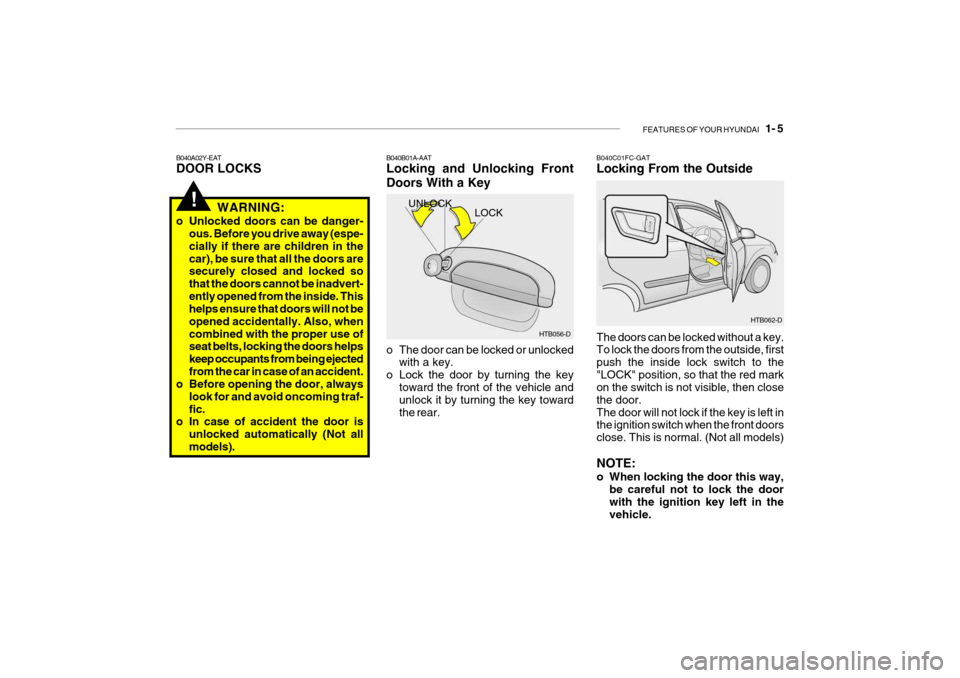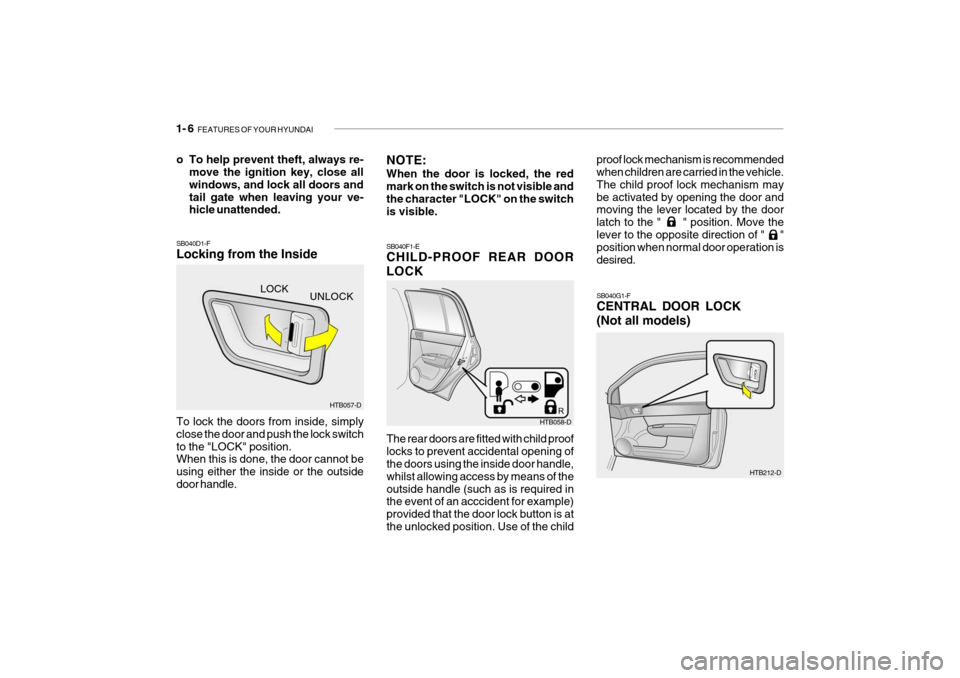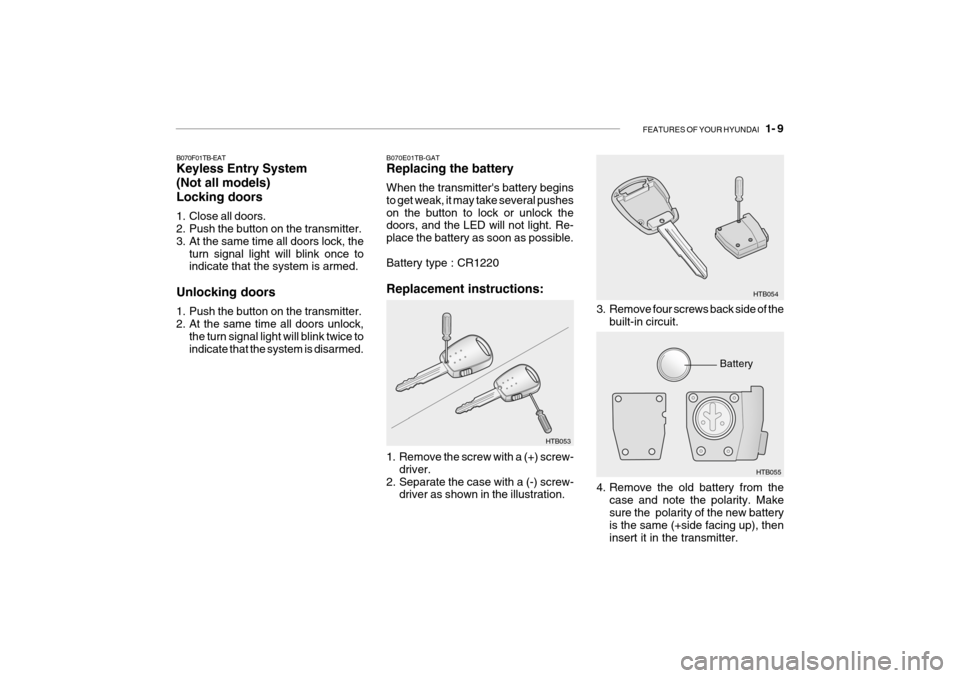Hyundai Getz 2005 User Guide
Manufacturer: HYUNDAI, Model Year: 2005, Model line: Getz, Model: Hyundai Getz 2005Pages: 437, PDF Size: 11.19 MB
Page 11 of 437

YOUR VEHICLE AT A GLANCE
B255A01TB-GAT INDICATOR SYMBOLS ON THE INSTRUMENT PANEL * A detail explanations of these items will be found on page 1-37
SRS (Airbag) Service Reminder Indicator ABS Service Reminder Indicator Turn Signal Indicator Lights High Beam Indicator Light Oil Pressure Warning Light Parking Brake/Brake Level Warning Light Charging System Warning Light Tail Gate Open Warning LightDoor Ajar Warning Light and Chime
Low Fuel Level Warning Light Malfunction Indicator Light Seat Belt Reminder Light
O/D OFF Indicator (Automatic transaxle only)
Electric Power Steering System (EPS)Warning Light
Diesel Pre-heat Indicator Light (Diesel only)
Fuel Filter Warning Light (Diesel only)
Immobilizer Indicator
Page 12 of 437

1. FEATURES OF YOUR HYUNDAI
Fuel Recommendations ................................................................... 1-2
Running In Your new Hyundai ......................................................... 1-3
Immobilizer system .......................................................................... 1-4
Door locks (Theft-alarm system) ..................................................... 1-5Power windows.............................................................................. 1-10
Seat ................................................................................................ 1-11
Seat Belt ......................................................................................... 1-17
Child restraint system .................................................................... 1-22
Supplemental restraint (AIRBAG) system .....................................1-30
Instrument cluster and indicator lights ............................................1-37
Warning Light and Indicator ............................................................ 1-39
Trip computer ................................................................................. 1-46
Multi-Function Light Switch............................................................ 1-48
Windshield wiper/Washer Switch ...................................................1-50
Sunroof ........................................................................................... 1-55
Mirror ......... ..................................................................................... 1-59
Bonnet Release .............................................................................. 1-62
How to use luggage Room ............................................................. 1-66
Heating and cooling control ............................................................ 1-71
Stereo sound system ..................................................................... 1-80
Antenna .......................................................................................... 1-84
1
Page 13 of 437

1- 2 FEATURES OF YOUR HYUNDAI
B010A03O-EAT FUEL RECOMMENDATIONS Petrol Engines THIS VEHICLE MUST ONLY BE OP- ERATED WITH UNLEADED FUEL. SERIOUS DAMAGE WILL RESULTFROM THE USE OF LEADED FUEL. The use of leaded fuel in this vehicle will result in irreversible pollution of the catalyst element. Such pollution willprevent correct operation of the cata- lyst and give rise to increased operating temperatures leading to the catalystelement melting and restricting the ex- haust flow along with an increase in exhaust emission levels.
Unleaded fuel with a Research Octane Number (RON) of 91 or higher must be used in this vehicle.To prevent accidental filling of the fuel tank with leaded fuel, a small diameter filler neck along with a restrictor flap arefitted to ensure that only unleaded fuel pump nozzles may enter the filler neck. However, care must be exercised whenfilling the vehicle tank from jerry cans or by means of a funnel that the fuel being used is unleaded. HTB187
!
CAUTION:
The vehicle warranty will not extend to damage arising from the use of incorrect fuels. Diesel Engines Diesel fuel of 52 to 54 cetane is used in Hyundai vehicle. If two types of diesel fuel are available, use summer or winterfuel properly according to the following temperature conditions.
o Above 23°F (-5°C) ... Summer type diesel fuel.
o Below 23°F (-5°C) ... Winter type diesel fuel.
! Watch the fuel level in the tank very carefully : If the engine stops due to fuel failure, the circuits must be completelypurged to permit restarting.
CAUTION:
Do not let any petrol or water enterthe tank. If this happens, the tankshould be completely drained and the fuel lines should all be cleaned out. This will stop the fuel pumpfrom becoming contaminated.
Overseas Operation: When the vehicle is to be operated overseas, the vehicle operator should establish that a suitable fuel for satis-factory operation of the vehicle is avail- able. SB010E1-E FUELS FOR CLEANER AIR To help contribute to cleaner air, Hyundai recommends that you use fuels treated with detergent additives, which help to prevent deposit formation in the engine.These fuels will help the engines run cleaner and the Emission Control Sys- tem performance.
Page 14 of 437

FEATURES OF YOUR HYUNDAI 1- 3
B020A01FC-EAT RUNNING IN YOUR NEW HYUNDAI (Petrol Engine) The longevity and performance of the vehicle are greatly affected by the care exercised during the first 1,000 miles ofmotoring. Because of modern manu- facturing techniques, rigid guidelines regarding maximum road speeds havebecome unnecessary. However, cer- tain precautions should be observed in order to obtain the best possible perfor-mance and useful life from the vehicle.
1) Do not race the engine without a load
(i.e revving the engine in neutral).
2) During the first 500 miles the maxi-
mum engine speed should be re- stricted to 3,000 rpm and gradually increased thereafter.
3) Avoid prolonged constant speed op- eration. The internal components ofthe engine will become more quickly run in if the operation speed is variedduring the running-in period.
4) Never allow the engine to labour. Use
the gearbox freely and avoid largethrottle openings when the engine speed is below 1,500 rpm.
5) Avoid rapid acceleration and maxi- mum throttle openings.
6) Avoid harsh braking during the first
100 miles of urban motoring or 1,000 miles of motorway driving to allow the friction facings of the brake pads and shoes to bed against the discsand drums properly.
7) No trailer towing should be under-
taken during the running-in period.
B020B01FC-EAT (Diesel Engine) The longevity and performance of the vehicle are greatly affected by the care exercised during the first 1,000 miles of motoring. Because of modern manu- facturing techniques, rigid guidelinesregarding maximum road speeds have become unnecessary. However, cer- tain precautions should be observed inorder to obtain the best possible perfor- mance and useful life from the vehicle. 1) Do not race the engine without a load
(i.e revving the engine in neutral).
2) During the first 600 miles the maxi- mum engine speed should be re-stricted to 3,000 rpm and gradually increased thereafter. And while driv-ing, keep under three quarters of maximum vehicle speed.
3) Avoid prolonged constant speed op- eration. The internal components ofthe engine will become more quickly run in if the operation speed is variedduring the running in period.
4) Never allow the engine to labour. Use
the gearbox freely and avoid largethrottle openings when the engine speed is below 1,500 rpm.
5) Avoid rapid acceleration and maxi- mum throttle openings.
6) Avoid harsh braking during the first
100 miles of urban motoring or 1,000 miles of motorway driving to allow the friction facings of the brake pads and shoes to bed against the discsand drums properly.
7) No trailer towing should be under
taken during the running in period.
Page 15 of 437

1- 4 FEATURES OF YOUR HYUNDAI
6SB035A1-FE IMMOBILISER SYSTEM The immobiliser system is an anti-theft device, designed to prevent and detervehicle theft. B880B03A-GAT Keys All of the locks fitted to the vehicle are operated by the same key. However,since it is possible to lock the doors without the use of the key, care should be exercised to ensure that the keydoes not become locked inside the vehicle by mistake. NOTE: If you make your own duplicate key, you will not be able to cancel the system or start the engine. B880C02A-GAT Key Numbers The vehicle key number is recorded upon a metal tag attached to the keys when the vehicle is first delivered toyou. The key number should be recorded and kept in a safe place in case theneed to order further keys arises. New keys are available from any Hyundai authorised repairer by quoting the rel-evant key number.
B880C01L
In the interest of security, the metal tag attached to the keys which bears the key number should be removed fromthe key ring after you receive your new vehicle. In addition, key numbers can- not be provided by Hyundai for securi-ty reasons. If you need additional keys or if you should lose your keys, your Hyundaiauthorised repairer can make new keys.
Page 16 of 437

FEATURES OF YOUR HYUNDAI 1- 5
B040A02Y-EAT DOOR LOCKS B040B01A-AATLocking and Unlocking Front Doors With a Key
o The door can be locked or unlocked
with a key.
o Lock the door by turning the key toward the front of the vehicle and unlock it by turning the key toward the rear. B040C01FC-GAT Locking From the Outside
The doors can be locked without a key. To lock the doors from the outside, first push the inside lock switch to the"LOCK" position, so that the red mark on the switch is not visible, then close the door.The door will not lock if the key is left in the ignition switch when the front doors close. This is normal. (Not all models) NOTE:
o When locking the door this way, be careful not to lock the door with the ignition key left in thevehicle.
LOCK
HTB056-D
UNLOCK
HTB062-D
!WARNING:
o Unlocked doors can be danger- ous. Before you drive away (espe- cially if there are children in thecar), be sure that all the doors are securely closed and locked so that the doors cannot be inadvert-ently opened from the inside. This helps ensure that doors will not be opened accidentally. Also, whencombined with the proper use of seat belts, locking the doors helps keep occupants from being ejectedfrom the car in case of an accident.
o Before opening the door, always
look for and avoid oncoming traf-fic.
o In case of accident the door is
unlocked automatically (Not allmodels).
Page 17 of 437

1- 6 FEATURES OF YOUR HYUNDAI
SB040G1-F CENTRAL DOOR LOCK (Not all models)
SB040D1-F Locking from the Inside To lock the doors from inside, simply close the door and push the lock switchto the "LOCK" position. When this is done, the door cannot be using either the inside or the outsidedoor handle. SB040F1-E CHILD-PROOF REAR DOOR LOCK
The rear doors are fitted with child proof locks to prevent accidental opening of the doors using the inside door handle, whilst allowing access by means of theoutside handle (such as is required in the event of an acccident for example) provided that the door lock button is atthe unlocked position. Use of the child
o To help prevent theft, always re-
move the ignition key, close allwindows, and lock all doors andtail gate when leaving your ve- hicle unattended.
NOTE: When the door is locked, the red mark on the switch is not visible and the character "LOCK" on the switchis visible. proof lock mechanism is recommended when children are carried in the vehicle. The child proof lock mechanism maybe activated by opening the door and moving the lever located by the door latch to the " " position. Move thelever to the opposite direction of " " position when normal door operation is desired.
HTB057-D
UNLOCK
LOCK
HTB058-D
HTB212-D
Page 18 of 437

FEATURES OF YOUR HYUNDAI 1- 7
B070A01A-EAT ANTI-THEFT ALARM SYSTEM (Not all models) This system is designed to provide protection from unauthorized entry into the car. This system is operated inthree stages: the first is the "Armed" stage, the second is the "Alarm" stage, and the third is the "Disarmed" stage. Iftriggered, the system provides an au- dible alarm with blinking of the turn signal lights.
The central door locking is operated by pushing the driver's door lock switch toward the front or rear of the vehicle. Ifthe passenger and rear doors are open when the switch is pushed, the door will remain locked when closed. NOTE:
o When pushing the switch toward
the rear, all doors and tail gate will unlock. When pushing the switch toward the front, all doors and tail gatewill lock.
o When the door is unlocked, the
red mark on the switch is visibleand the character "LOCK" on the switch is visible.
o The central door locking is oper- ated by turning the key (with theft-alarm system: driver's door and passenger's door, without theft-alarm system: driver's door only) toward the front or rear of the vehicle. Park the car and stop the engine. Arm the system as described below.
1) Remove the ignition key from the
ignition switch.
2) Make sure that the engine bonnet and hatchback door are closed.
3) Lock the doors using the transmitter
of the keyless entry system.
After completion of the steps above, the turn signal lights will blink once toindicate that the system is armed. NOTE:
1) If any door, hatchback door or engine bonnet remains open, the system will not be armed.
2) If this happens, rearm the system
as described above.
CAUTION:
Do not arm the system until all pas-sengers have left the car. If the sys- tem is armed while a passenger(s)remains in the car, the alarm may be activated when the remaining passenger(s) leaves the car.
!
HTB052-D
B070B01O-EAT Armed Stage
Page 19 of 437

1- 8 FEATURES OF YOUR HYUNDAI
HTB202
B070D02TB-AAT Disarmed Stage
B070C02FC-EATAlarm Stage The alarm will be activated if any of the following occurs while the car is parkedand the system is armed.
1) A front or rear door is unlocked and
opened without using the transmit- ter.
2) The hatchback door is opened with-
out using the transmitter.
3) The engine bonnet is opened. The alarming horn will sound and the turn signal lights will blink continuously for 27 seconds. To turn off the system,unlock the door or hatchback door with the transmitter. The system will be disarmed when thedriver's or passenger's door is un- locked by depressing the button on thetransmitter. After completion of the step above, the turn signal lights will blink twice to indicate that the system is disarmed. NOTE: When the vehicle is unlocked using the unlock button on the remote, but the doors, bonnet or boot are not opened within 30 seconds, the doorswill relock and the system will re- arm. CAUTION:
Only the transmitter can disarm thearmed stage. If the transmitter does not disarm the system, it is neces-sary to take the following steps;
1. Unlock the door with the key, which will cause, the alarm to be activated.
2. Insert the key in the ignition key cylinder and turn the ignition keyto "ON" position.
3. Wait for 30 seconds. After completing the step above, the system will be disarmed.
!
Page 20 of 437

FEATURES OF YOUR HYUNDAI 1- 9
HTB053
B070F01TB-EAT Keyless Entry System (Not all models)Locking doors
1. Close all doors.
2. Push the button on the transmitter.
3. At the same time all doors lock, the
turn signal light will blink once to indicate that the system is armed.
Unlocking doors
1. Push the button on the transmitter.
2. At the same time all doors unlock, the turn signal light will blink twice to indicate that the system is disarmed. B070E01TB-GAT Replacing the battery When the transmitter's battery begins to get weak, it may take several pusheson the button to lock or unlock the doors, and the LED will not light. Re- place the battery as soon as possible. Battery type : CR1220 Replacement instructions:
1. Remove the screw with a (+) screw-
driver.
2. Separate the case with a (-) screw- driver as shown in the illustration. 3. Remove four screws back side of the
built-in circuit. HTB054
HTB055
Battery
4. Remove the old battery from the case and note the polarity. Make sure the polarity of the new battery is the same (+side facing up), then insert it in the transmitter.